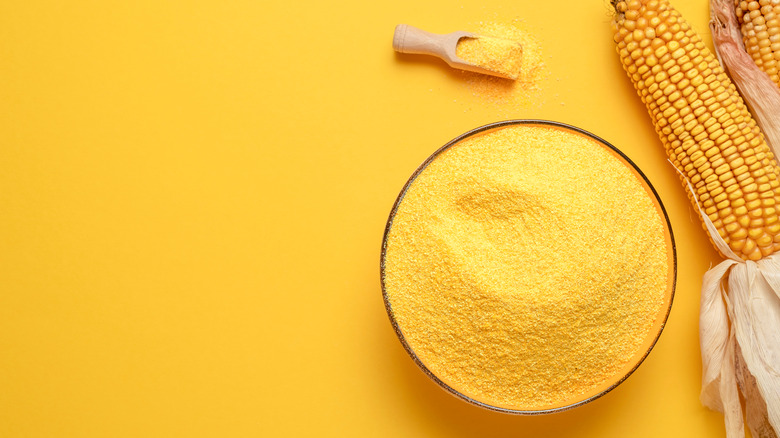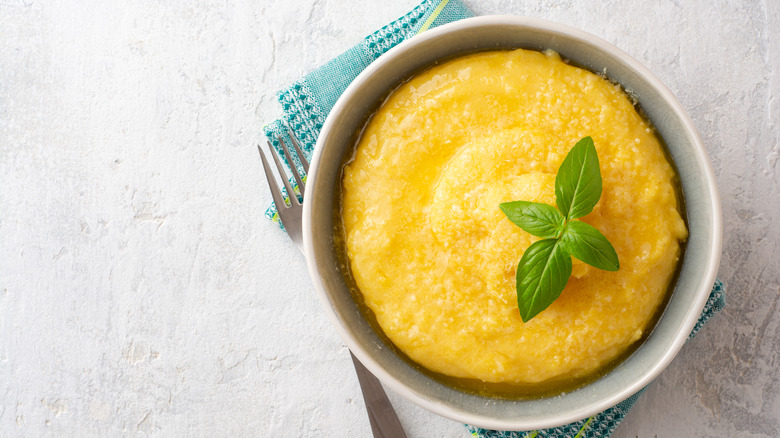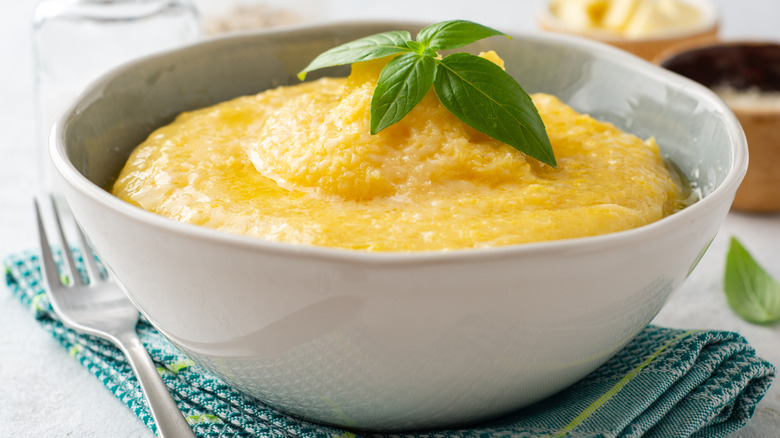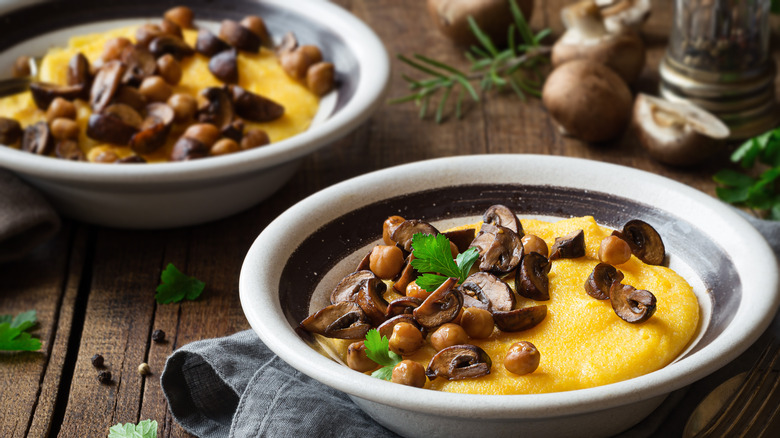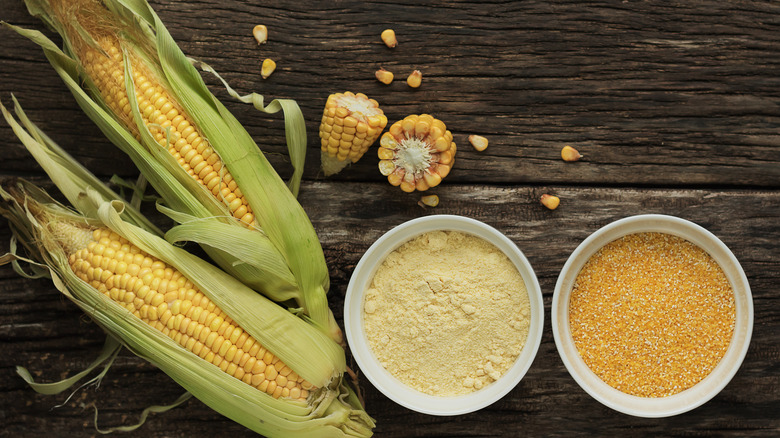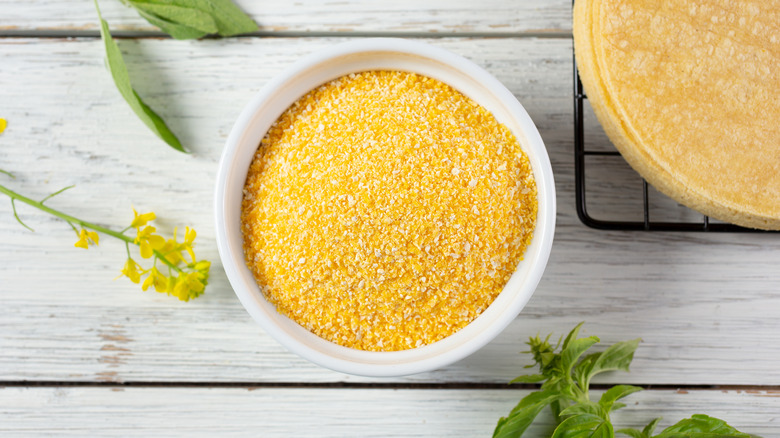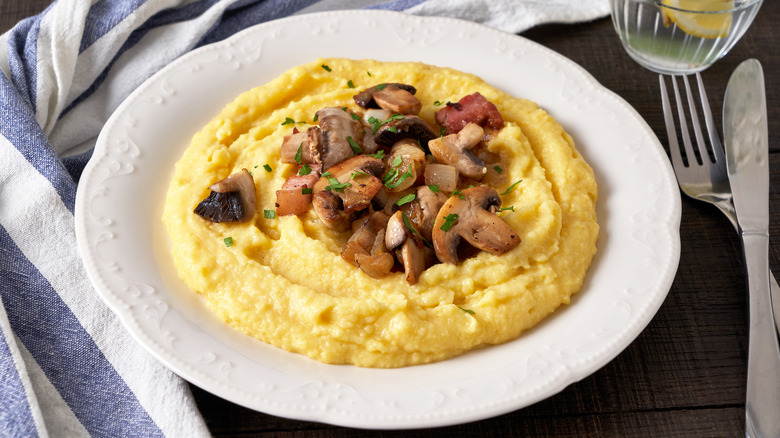What Is Polenta And What Does It Taste Like?
If you've ever enjoyed what's commonly known as "hot porridge," it's quite possible you were taking a bite of polenta. This Italian dish is similar to grits and is likewise eaten nice and hot. While it isn't a hugely popular food in the U.S., it's been gaining traction in recent years and has become a menu option even at gourmet restaurants.
Polenta is very well-known throughout Europe. The dish originated in northern Italy in the 16th century, and it was served as a food for the poor, such as peasants or even working-class families, says Delallo, thanks to the meal's affordability and convenience. Historically, it was once a simple dish and cheap to buy. But polenta is now considered a versatile option that can be served in fancier ways than before, as cooks use it for both sweet and savory dishes. Many times, it's paired with stars such as short ribs, pork, or even a Tuscan salad.
There's plenty to appreciate about this dish, including its origins as well as how to use it for your next dinner.
What is polenta?
Polenta is essentially just boiled cornmeal (which, naturally, comes from corn) and is a hearty starch. Yellow maize is the main ingredient in polenta, but buckwheat and white maize can also be used to make it, along with a combination of all three in some cases.
The dish is made from a base of dried corn kernels that have been stone ground, and the result is a gritty, fine texture. It originated from flint corn, a type that is native to Italy. Flint corn is a bit heartier than other ears, making it a very satisfying base for polenta that lends itself well to different ingredients and flavors that can be added in.
As such, polenta is a very versatile dish. And like American grits, can be utilized for a meal at any time of day. Based on the preparation of the dish you're making, you will generally be able to pick one of five options for your polenta, whether it's coarse ground, finely ground, instant, white, or precooked.
What does polenta taste like?
The flavor profile of polenta is incredibly satisfying, offering a sweet corn taste with a texture and consistency similar to that of porridge. A similar comparison would be a bowl of grits with a flavor pop of cornbread. But because polenta comes from flint corn, which is less creamy than its distant cousin, grits, the mouthfeel is a bit different between the two dishes.
The Spruce Eats suggests that beginning with good quality cornmeal is key to making the best polenta. Being choosy and picking the highest-quality cornmeal variety you can buy will allow the flavor to stay sweet and robust, rather than bitter and raw.
Simple30 also recommends purchasing actual polenta when a recipe calls for it, rather than going for the easy cornmeal option, as the two taste completely different; polenta is a dish, and cornmeal is just an ingredient in that dish.
How to cook polenta
While many eat polenta as a side dish after cooking it on the stovetop, you can also use polenta as an ingredient that's baked into bread or a cake of sorts, per Delallo. Polenta is malleable, forming to the shape of the container it's in; it can be grilled, sautéed, or pan-fried.
To make it the traditional way, bring a pot of lightly salted water to a boil. Once the water is at a steady rumble, throw in your polenta grains and cook for around 45 minutes, says The Spruce Eats. Make sure you stir it consistently as it cooks so that the grain will cook evenly and puff up to the desired texture. To add more flavor, swap out the water for chicken stock and add thyme, a bay leaf, and some chili flakes for extra spice, recommends Real Simple. You can also add cheese into polenta, similar to cheese grits.
A simple polenta seasoning mix includes butter, salt, and fresh grated Parmesan cheese, says All Recipes. Once cooked, the dish can be served with roasted veggies or any kind of meat, or you can try it at breakfast with a poached egg. And if you want to get really creative, let the polenta cool and firm up, and then you can cut it up into pieces and serve it as polenta fries, use it as a starchy substitute for pasta noodles, or layer it with meats and cheeses like a lasagna, suggests Delallo.
Can you substitute polenta?
Depending on how you cook it, there are a variety of acceptable substitutes for polenta if you're in a pinch.
We've mentioned how similar polenta is to grits. And while it's true that polenta is not as common in the U.S. as grits are — a very part of the fabric of Southern comfort food — grits can be a good substitute for polenta. If you want a bowl of polenta for breakfast, for example, morning grits mixed with sugar would suffice, as would other substitutes such as oatmeal or cream of wheat.
For lunch or dinner options, most starches are good swaps. Potatoes, a number of pastas, and risotto will all work well as a side dish or a polenta replacement. When cooking or baking, if your dish calls for cornmeal (the main ingredient in polenta) you could also use corn grits or semolina, says Robust Kitchen.
Where to buy polenta
If you want to try your hand at a homemade polenta dish, the good news is that you can find it at pretty much any grocery store. You won't have to head to an Italian market or specialty store to buy this grain.
When shopping for polenta, opt for well-known and respected brands including Colavita Polenta, Delallo Instant Polenta, or Shilo Farms.
If you opt for tubed polenta, it might be in the refrigerated section of your grocery store with the fresh pasta, explains Thrive Cuisine. Shelf-stable tubed polenta may be in the grain aisle with pasta, gnocchi, rice, and the like. It could also be in the international aisle, if there's a section dedicated to Italian foods. Boxed instant polenta, meanwhile, may be stored alongside grits and specialty flours, notes Thrive Cuisine. Basically, there are a lot of places polenta could be stocked, so don't be afraid to ask for help finding it.
Nutritional information about polenta
Polenta that's unseasoned and not cooked with cream or cheese is fairly low in calories and still contains a decent amount of vitamins and minerals, says Heathline. But don't forget that it's a grain, meaning there's a hefty concentration of carbs. In about a 3/4-cup serving of cooked polenta, there are 80 calories, 17 grams of carbs, 2 grams of protein, less than 1 gram of fat, and 1 gram of fiber.
The type of polenta you buy is also important when it comes to nutrition and taste, says Healthline. Polenta that comes in a tube has similar health values, but far less flavor. And in general, pre-packaged or pre-cooked versions are made from degerminated corn, meaning the innermost part of the corn kennel, the germ, is removed. Doing so sacrifices most of the healthy fat content and essential nutrients, including vitamins B and E. If you want to gain more nutrients back, the site says, you could cook it with fortified milk instead of water, although the calorie count will increase.
Because polenta is naturally gluten-free, it is great for those with gluten intolerances or Celiac disease.
